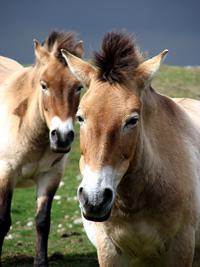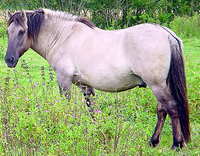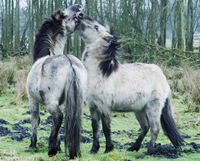WhereTo See Wild Horses
View AnimalTourism.com Wild Horses in a larger map
WILD HORSES TODAY: current situation and conflicts
The United States
The horse originated and evolved in North America for 55 million years. Horses disappeared when people showed up 10,000 years ago. But by then horses had crossed to Asia, then Europe. Spanish settlers brought horses. Descendents of those horses (and other former domestics) make up today's wild horse population in the Americas. Some consider them a reintroduction of a species wiped out by earlier Americans. Others, especially cattle ranchers, think they're a feral, exotic species that should be removed.
By the 1800s about 2 million wild horses grazed the U.S. For decades horses starved on the range or were shot for fun or because they intfered with grazing livestock. 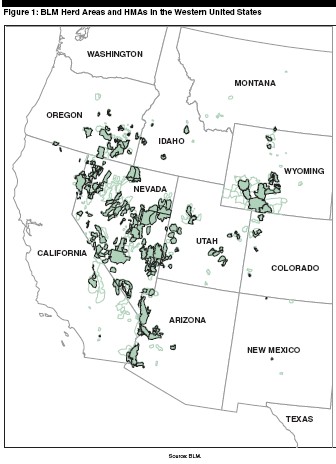
In 1971, wild horses gained federal protection. Since then horses in the west have been managed--or mismanaged--by the Bureau of Land Management in 199 herds in 10 states. The BLM has reduced their range and wants to cut their numbers from 33,000 to 27,000.
Each year the BLM rounds up and auctions horses. Not nearly enough buyers appear, especially in a collapsing horse market. So the BLM has amassed a staggering 33,000 mustangs in captivity. Then, flaunting the $27 million pricetag for this absurd practice, suggested euthanasiznig the horse or selling them to horse slaughter.
Madeleine Pickens recently offered to buy or lease one million acres as a retirement home for wild horses, creating the world's biggest wild horse sanctuary. A bill that passed the house would reform some BLM practices.
Worldwide
Around the world there are small pockets of wild horses: the Bahamas, Brazil, Namibia and even Europe. Most are descended from domesticated horses that escaped or were abandoned in hard times.
Przewalski's Horse Przewalski's horse (pronounced sheh-val-skees) is the only truly wild horse. Discovered in Mongolia by a Russian adventurer who gave them their name, the horse went extinct in the wild in 1969. The horses around today were bred from a line that started with a handful shipped to the Askania-Nova Nature Center in Ukraine. Thanks to a worldwide, breeding effort, the Przewalski's horse has been released back into the wild Mongolia and China. It also goes by Takhi, Asian Wild Horse, Mongolian Wild Horse and (more formally) Equus ferus ssp. przewalskii. They have an erect mane and dark line down their back--a look shared by other primitive horses. |
Photo by Taylor Dundee |
Tarpan A few other primitive horses are floating around: Tarpans, which went extinct in 1876. Heinz and Lutz Heck bred an approximation. About 100 of these genetic concoctions live in zoos and with breeders and are called tarpans (even though they're really not). |
Photo by Nuakin |
Konik The tarpan last lived in eastern Europe, especially Poland's Białowieża Forest. The Polish government rounded up horses peasants had cross-bred and tried to back breed the Tarpans. Their attempt is called the Konik (and sometimes the Polish Pony). Koniks run wild or semi-wild in Poland, the Netherlands and England. |
Photo by Harry Harms |
Camargue Horses The Camargue horses of the marches of the south of France are a bit of a mystery. The going theories are that these gray-white enigmatic beauties may have come from the solutrean horse from around 50,000 B.C. or 8th Century Romans. These white (or gray) horse were traditionally used by locals to round up the semi-wild black bulls. |
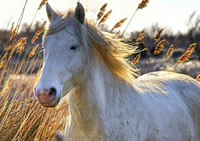 Photo by Wolfgang Staudt Photo by Wolfgang Staudt |
VIEWING TIPS
If you see wild horses in areas prone to tourists, don't feed them--especially not out of your car. That could lead to the horses hanging out by the road to get food and getting hit by a car.
BEST PLACES TO SEE WILD HORSES
| Click on the region to see its best animal places | ||||||
| U.S. | ||||||
| International | ||||||
| The West - See other animals out West | |
|
|
Lifesavers Wild Horse Rescue Lifesavers Wild Horse Rescue has about 200 wild horses they've rescued just about 90 minutes from Los Angeles. You can visit and tour this huge facility they gentle the horses for potential adoptions. They are also setting up the Born To Be Wild Sanctuary near Twin Oaks to let the horsesroam free, especially the ones that have lived wild their whole lives and fear humans. The group is continually rescuing horses, saving hundreds at auction that would have gone to Mexico for slaughter. 230809 E Avenue J, Lancaster, CA 661-727-0049 |
|
|
Wild Horse Sanctuary The Wild Horse Sanctuary saved 80 mustangs that the Bureau of Land Management wanted to destroy and gave them this 5,000 acre ranch to roam. You can support the herd by going on their 2 or 3-day trail rides ($435-535) or volunteering. You can also just donate or see the horses Wed. and Sat. 10-4. 5796 Wilson Hill Rd Shingletown, CA (530) 335-2241 Near Redding. |
|
Virginia City, NV Wild Horses,
Nevada tourism officials say the Virginia Highlands around Virginia City is a good place to try to see them off rout 341. "The horses are seen in meadows high in the mountains, at about the 6000-foot level. They are not always visible." Nevada has more wild horses than any other state. The Bureau of Land Management estimates there are about 15,000 wild horses and 800 wild burros in Nevada. However that doesn't make them easy to see. Mustangs4us gives a good review of what the state offers. |
|
Dayton, NV Wild Horses US 50
Nevada tourism officials say U.S. 50 running east out of Carson City to Dayton is a good place to see the horses grazing or running through the sagebrush.
Nevada has more wild horses than any other state, thousands of animals in hundreds of herds. The Bureau of Land Management estimates there are about 15,000 wild horses and 800 wild burros in Nevada. However that doesn't make them easy to see. Mustangs4us gives a good review of what the state offers. |
|
National Wild Horse & Burro Center
This National Wild Horse and Burro Center, 20 miles north of Reno is where the Bureau of Land Management holds thousands of captured wild horses awaiting potential adoption. You can see and perhaps adopt a wild horse here. 17800 State Route 445, Palomino Valley, NV (775)475-2222 map » |
|
Pilot Butte Wild Horse Scenic Loop
The Pilot Butte Wild Horse Scenic Loop is a 23-mile drive on gravel roads that takes you near 2,500 of Wyoming's 6,000 wild horses. You can check in with the Bureau of Land Management's Rock Springs field office along U.S. 191 just 1.5 miles north of Interstate 80. They put up a viewing area and informational plaques.(307) 352-0256, Office hours: 7:45am - 4:30pm, M-F Bonus animals: antelope, desert elk, deer, rabbits, coyotes, eagles or sage grouse. To begin the loop from Rock Springs, take exit 104 off Interstate 80 to U.S. 191 and continue north 14 miles to County Road 14. Turn left and head 2.5 miles to County Road 53, also on your left. From Green River, exit Interstate 80 at Flaming Gorge Way, turn left onto Trona Drive at the next intersection and follow it north as it turns into a dirt road and passes beneath the interstate. |
|
Rock Springs Wild Horse Facility
The Rock Springs Wild Horse Facility is part of the Bureau of Land Management's program to protect the 30,000-some wild horses out west. You can visit these corrals on Lionkol Road off Route 191, north of Rock Springs, WY.From I-80 in Rock Springs, take the Elk Street exit and go north 1 mile. Turn right (east) onto Lionkol Road and go about a 1/2 mile. (307) 352-0302 |
|
Black Hills Wild Horse Sanctuary
The Black Hills Wild Horse Sanctuary gives 500 wild horses an 11,000 acre place to roam. The herd comes includes American Spanish Mustangs, Sulphur and Kiger Mustangs.--all kinds of wild horses.
You can visit for two hours ($50) or all day ($750 for three) on bus tours that also take you to see Petroglyphs. Make reservations. From Hot Springs, go 12 miles down 71 cross Cheyenne River Bridge, first right on Rocky Ford Road and then right on Highland Road go 3 miles to Visitor’s Center. (800) 252-6652 (605) 745-5955 |
|
Onaqui Herd Management Area
The Onaqui Herd Management Area has one of the biggest herds of wild horses in Utah--up to 275 horses. The Bureau of Land Management wants to cut the herd down to 70 to 120. Most are descendants of escaped ranch horsees. According to MUSTANGS 4 US, the area extends from Johnsons Pass south to Look Out Pass. Wild horses can be seen on the bench and flat areas along the east and west sides of the mountain range. 2370 S 2300 W, West Valley, UT map » |
| Midwest - See other animals in the Midwest | |
|
Wild Horses of Theodore Roosevelt National Park-ND near MT
Theodore Roosevelt National Park has wild horses that roam the south unit near Painted Canyon and Peaceful Valley. The park maintains a herd of 70-110 horses. When the herd grows bigger every few years, they round up and auction off the horses. South Unit (701) 623-4466
The South Unit entrance and South Unit Visitor Center are located in Medora, just off Interstate 94 (exits 24 & 27) and is 133 miles west of Bismarck, ND and 27 miles east of the Montana state line. map » |
| Northeast - See other animals in the Northeast | |
|
Assateague The wild horses of Assateague are divided along the MD-VA state line. The lucky ones are in Maryland, which uses contraceptives to disrupt the lives of the horses the least. A friendly ranger told me that she's never known anyone to go on the island on their side and not see a horse. |
| South - See other aninals Down South | |
|
Corolla Wild Horses
. The Corolla Wild Horses live on the section of the top of Bodie Island. After many horses were killed in car accidents, Corolla Wild Horse Fund
organized a move for the horses to an remote area protected by a fence. You need a four wheel drive vehicle to drive on this part of the island and even then they're not easy to find.. Many companies offer tours. map » |
|
Ocracoke Wild Ponies
Saying this tiny small band of wild ponies in a pen are a bunch of wild horses is probably an insult to wild horses everywhere. Well, at least they're not used to people. The boyscouts of the gorgeous island used to round them up once a year. After too many car accidents, they live in their expansive pen off Rt. 12, the main road on the island, which you can only reach by ferry. |
| Texas - See other animals in Texas | |
Karma Farms
The horses at Karma Farms aren't wild, but they are a pure representation of the Colonial Spanish Horse, also known as Colonial Spanish, the Horse of the Americas, but also Colonial Spanish, Spanish Mustang, Barb, Original Indian Horse, and Cayuse. This rare breed has fierce loyalists who consider among the most versatile and independent in the world.
Trail riding at $25 an hour. East Texas between Marshall and Jefferson on US 59, only about 12 miles north of I-20. 7925 US Highway 59 N, Marshall, TX 75670 (903) 935-9980 map » |
|
| Canada -- See other animals in Canada | |
Sable Island, Canada Sable Island has a herd of 300 wild horses, probably the largest herd of unmanaged horses in the world. |
|
| Latin America -- See other animals in Latin America | |
|
A tiny popululation of about 200 wild horses lives in Brazil's northern, rural province of Roraima. The Embrapa Roraima keeps track of them on the outskirts of Boa Vista. |
|
Abaco Horses, Bahamas Only eight wild horses survive today on Abaco. Long mythologized and seldom seen, the herd was tested in 1998 and found to be descendants of Spanish Barbs, untouched genetically for 250 years, according to Equiworld.net. |
|
| Europe - See other animals in Europe | |
|
The National Trust runs Wicken Fen outside Cambridge. The herd of Konik ponies get to roam the East Anglia wetlands in family and bachelor groups. The 42 horses are mainly on the the Adventurers' Fen and there's a small group on Verrall's Fen, at the west end of the reserve. |
|
The Wildwood Trust lets you see native European animals and tries to save the most endangered, like the Konik horses, the beaver, pine martens and red squirrels. The BBC describes them as bringing nature back 7,000 years. |
|
Koniks Near Amsterdam Near Amsterdam the Oostvaardersplassen is a nature park with roaming wild horses called Koniks and primitive cattle known as Heck Cattle. |
|
Koniks of Arnhem, The Netherlands Europe has wild horses, too. In The Netherlands, these half wild horses are called 'Koniks' and live in nature reserves near rivers, reports Martin Werker. live in cattles in nature reserves, often in the fore-lands of rivers. |
|
Ennenborg Estate, The Netherlands The Ennemborg Estate has a herd of about 40 Koniks on 170 hectares. They are doing so well that they continually donate the primitive horses to other parks throughout Europe. Harry Harms documents their antics, including eating the bark off trees when hungry. |
|
Lauwersmeer National Park, The Netherlands Lauwersmeer National Park started in 1969 when a dike was built between a lake and the sea on the Groningen-Frisian border. |
|
Neanderthal Wildpark - Germany The Neanderthal Wildpark (Wildhedge Neandertal) recreates the landscape that neanderthal humans would have experienced in Europe 30.000 years ago. Wisent (bison), tarpan (wild horse) and auroch (primitive cattle) roam.
The tarpan is the original wild horse that they've tried to breed backwards using Przwalski horses with Icelandic ponies and Swedish Gotlands.
About 20 of the 200 existing auroch or Heck cattle live here.
0049 - 2104 - 139 155
40699 Erkrath, GermanyThekhauser Quall |
|
Camargue Wild Horses - France Camargue, a French regional park on the Mediterranean, is one of the best wildlife spots in Europe. It is home to the Camargue Horse and one of the few places in Europe you can see pink flamingos. This special breed of small horse may be descended from Solutre horses 17,000 year ago. About 30 herds roam the area. |
|
Roztocze National Park - POLAND Poland's Roztocze National Park (Roztoczański Park Narodowy) has a breeding population of Koniks. |
|
|
A large number of private and government farms raise Konik horses around Sieraków, Poland. This is where the primitive Tarpan horses were first distributed to peasants, who cross-bred them with other horses. Later they were collected to recreate the species at a breeding center that's been around for 180 years. |
|
Askania-Nova Nature Center Ukraine Askania-Nova Nature Center has the biggest population of Przewalski's Horse in the world. German settler Friedrich Falz-Fein turned his estate into an animal reserve in 1887 and named it New Germany. He imported lots of exotic animals like gazelles, camels and wild horses, Ukranians say. It got the first Przewalski horses in Europe and bred them for 40 years. The herd was wiped out in WWI, but the line survived in a German zoo. |
|
Vodnii Island, Russia he island is part of the Rostovsky Zapovednik Nature Preserve, in the Rostov Province. Local farmers used to let their horses roam onto what used to be a peninsula. After a 1953 dam it became an island. The farmers kept retrieving their horses, but the horses kept going back to their island paradise. These are Don horses (Equus caballus). The island is a big migratory bird route. Bonus species: Rare Eastern white pelicans (Pelecanus crispus) Dalmatian pelicans (P. onocrotalus) endangered Demoiselle cranes (Anthropoides virgo) |
|
Rucava, Latvia , Latvia is working with ARK (an environmental group with a focus on changing landscapes) on an experiment to let a herd of Koniks roam Latvia. After the fall of communism, many fields overgrew into forests; they needed grazing herds to keep a varied landscape. |
|
| Asia | |
Hustai National Park, China Przewalski's Horse - CHINA Thanks to an ambitous captive breeding program, 192 horses in 24 harems with 33 bachelor males roam freely in Hustai National Park. Others have been released -- for at least part of the year--in western Mongolia, China, Kazakhstan and Ukraine. |
|
Gobi B - Takhin Tal Nature Preserve - Mongolia The Takhin Tal Nature preseve in the northwest corner of Mongolia's Gobi B Strictly Protected Area is where Przewalski's horse were first released after it went extinct in the wild and was bred in captivity. |
|
Xinjiang Wild Horse Breeding Center, China Xinjiang Wild Horse Breeding Center is the heart of China's massive effort to save the Przewalski´s Horse from extinction. Since 1986 the center has been breeding the horses and releasing them to the wild in China, Mongolia, the Ukraine and Russia. |
|
Kalameili Nature Reserve, China A herd of Przewalski's horses are being gradually reintroduced to the Kalameili Nature Reserve (KNR), a 17,000 sq. km (almost 6,600 sq. miles) park in Xinjiang, China, between the Xinjiang Horse Breeding Center and the Gobi B Desert. The problem, according to Zoogoer, is that the horses can only roam in the summer; in the winter they are penned in again so that locals' cattle can graze. |
|
| Africa | |
Namibia Wild horses of the Namib are a herd of 100-150 feral horses that live on the edge of the dessert. Like many wild horse herds, no one is sure where they came from. Theories here range from shipwrecks, breeding farms and the German or South African Army in WWI. During droughts they have suffered greatly, so a relief fund is set up to provide them forrage. |
